Sonata Form: The Exposition
Outline of the Lecture with Links
I. The Character of the Main Theme(s)
Tends to be triad in nature, or at least to outline the tonic triad. Tendency towards "etched" style.
Tends to contain all of the motives to be used in the composition (for those composers who think motivically).
Tends to have clearly-etched rhythms.
Examples from Mozart's Piano Sonatas:
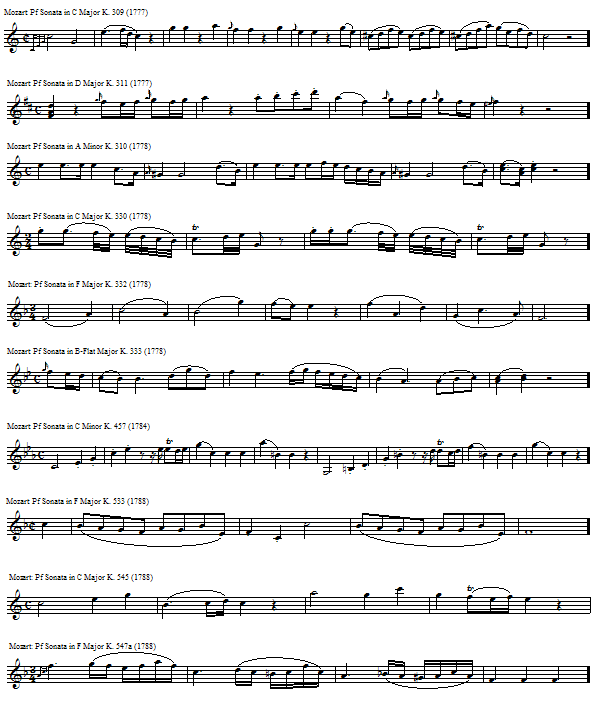
II. Transition: Techniques of Modulation
A. Half-cadence on V/V, with a clear break in the texture.
1.Mozart: Piano Sonata in B-flat Major, K. 333: the B-naturals begin to appear quite constantly -- I've marked them where they occur.
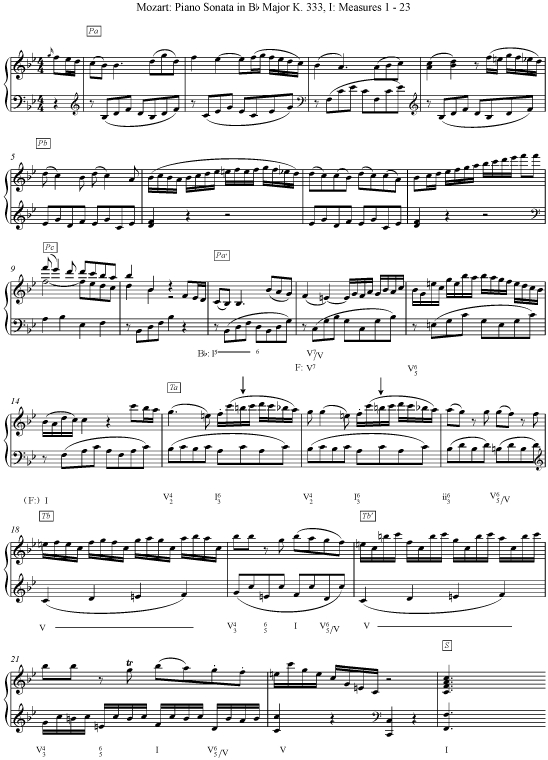
2. Haydn: String Quartet Op. 50, No. 2 in C Major 1 - 43: this one is really something. He begins by introducing the necessary accidental (C#) right near the beginning, heard as an accented passing tone in measure 3. He introduces the dominant by measure 12, but then returns back to the tonic at measure 19—thus conditioning us for the move that’s to happen, beginning at measure 30 and continuing onwards until measure 43. I have analyzed measures 9 – 19 as “1Ta and 1Tb”—in other words, placing a transitional theme between two statements of a P theme.
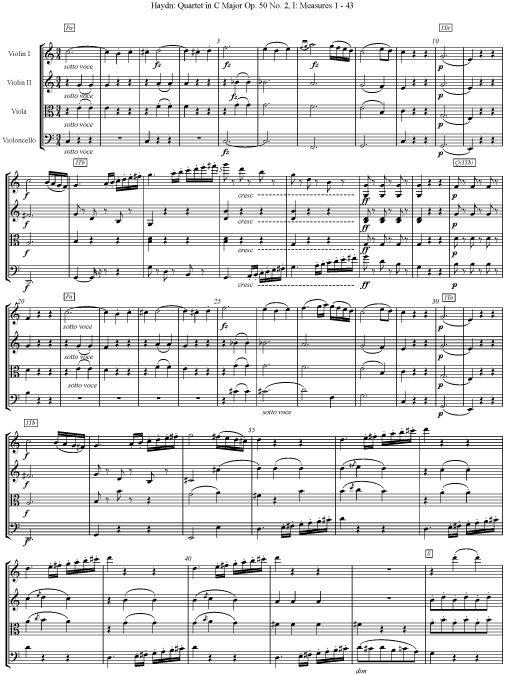
B. Half-cadence on V, followed by a new theme in the dominant (bifocal close)
1. Haydn Sonata H XVI:6, III: the most basic use of this technique.
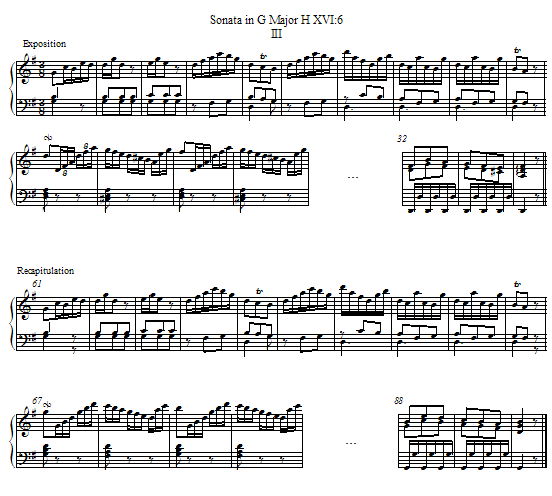
2. Mozart: Overture to Le Nozze di Figaro: here we have the standard bifocal close in one of its typical venus, an opera overture. (Inscidentally, Charles Rosen has said that Haydn might have considered this technique to be ‘beneath him’, but he used it in his earlier works.)
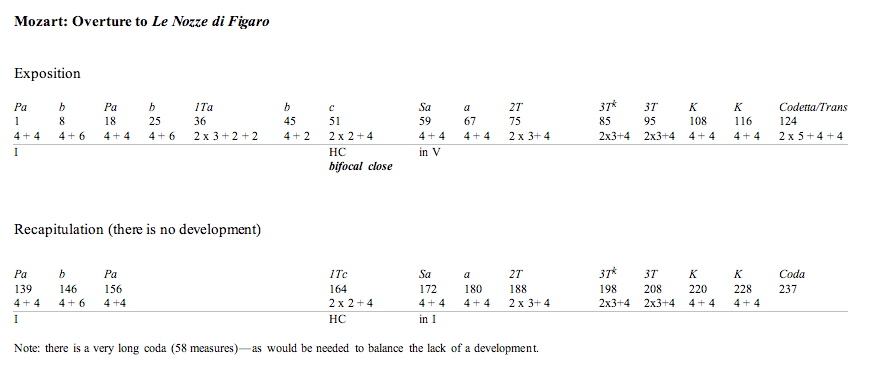
3. Haydn: Symphony No. 1 in D Major, II.
In the recapitulation, Haydn does, indeed, employ the material following the bifocal close transposed into the tonic without any other substantial change. However, his response to the bifocal-close problem is to bring the very arrival at the recapitulation itself into question and therefore set up an interesting pair of possibilities to the listener.
Either the recapitulation begins in measure 61 with the first really clear statement of expository thematic material in the tonic, in which case the movement is a binary sonata form. If that is the case, then the minor-key statement of the theme in measure 50 is a false recapitulation, followed by a full retransition at 57, then into the recapitulation at measure 61.
But it is possible that the recapitulation begins at measure 50, with T1 in the tonic minor. In this case, we have a standard sonata form, albeit one with an unusual opening for the recapitulation.
There is no reason to prove conclusively that one or the other scenario is the correct answer. In fact, it is the unsureness itself which gives the movement a much greater strength than it would have. To compare the effect, consider the following score of the development-recapitulation in which some judicious computerized cut-and-paste has re-created a recapitulation that follows the path of least resistance—i.e., it opens with 1-10 as in the exposition, then moves directly to measure 61. Thus the bifocal close at measure 10 is followed by a restatement of all of the expository material in the tonic key. Then compare that to Haydn’s actual composition; the difference is dramatic.
- Original version (audio excerpt)
- Alternate version (audio excerpt)
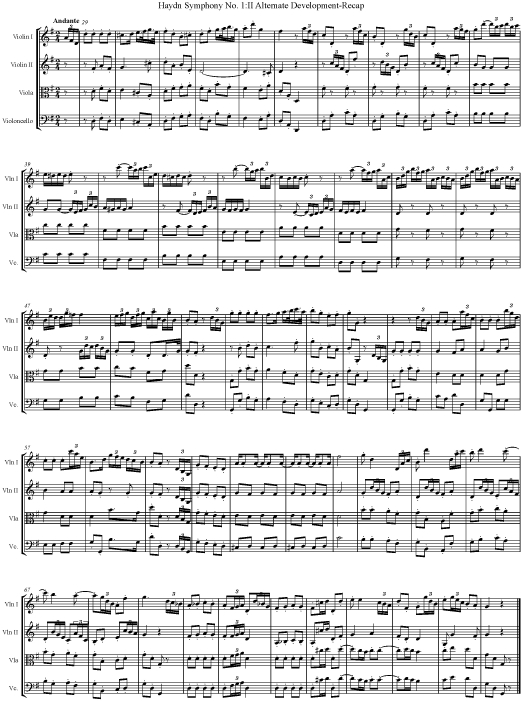
4. It's possible to write bifocal closes very, very badly. Consider Sammartini's Symphony in G, in which the move to the secondary theme (which begins on the dominant) is nothing short of jarring. Listen to the excerpt.
C. Sudden move to V/vi (i.e., dominant of relative minor) with a sequence following:
The following analyses of two Haydn symphonies may help to demonstrate this:
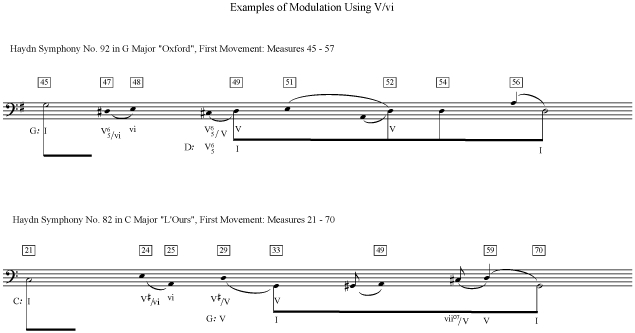
D. Other harmonic motions are possible: for example, a sudden V/ii to ii; V to I; V/V to V.
E. Rarely, but possibly, the secondary section might initiate the modulation -- i.e., the secondary key may not be reached as soon as the secondary theme.
F. Three-Key Exposition
Definition: a key intervening between tonic and dominant, with thematic materials of its own. This isn't a Haydn or Mozart feature; it is found in Beethoven and some later composers, including Brahms.
Beethoven Piano Sonata, Op. 10 No. 3:

Brahms: Symphony No. 2: from D Major, to F# Minor (although it has strong A Major overtones), to A Major and a series of second themes (one of which is the same as the F# Minor theme, but in unambiguous A Major instead.) Comparisons to the Haydn Op. 76 No. 3 (Emperor) quartet are strong--note the same way that the theme is brought back at the end. (In the case of the Haydn, it's the K theme; with the Brahms it is 1S. This return of the theme is why I consider the Brahms theme as 1S instead of a transitional theme.)

III. Character of the Secondary Theme(s)
A. Contrasting theme to the main theme
Typically, the contrasting second theme doesn’t have to carry as much harmonic weight as the primary theme; its key has been established by the preceding modulation. Given that it confirms, rather than establishes, a key, it is often much less emphatic about the tonic triad than the main theme, and can in fact be quite venturesome harmonically.
B. Same theme as the main theme
Many older textbooks seem to be unaware that the second theme may well be a restatement of the main theme, this time in the dominant key. That’s one of Haydn’s favored practices, which is sometimes referred to as monothematic sonata form—although it’s really nothing of the sort, given that there is invariably some kind of contrasting cadential theme, not to mention more than one secondary theme (of which only the first is the same as the main theme). It is not limited to Haydn, however: Mozart also made splendid use of it.
C. Use of the dominant minor instead of major
During the evolution of sonata form, it was common for the secondary theme to be stated first in the dominant minor. After a period of time, the dominant major won out—although typically the dominant minor might follow the major key. This is especially typical of Haydn’s early symphonies, but you will find it in many other composers in the 1750s and 1760s.
IV. Character of the Cadential Theme
Cadential themes rarely pose much in the way of difficulty. They’re generally closing-off patterns which are triadic and cadential in nature. Very often they aren’t really ‘themes’ at all, but just figures.